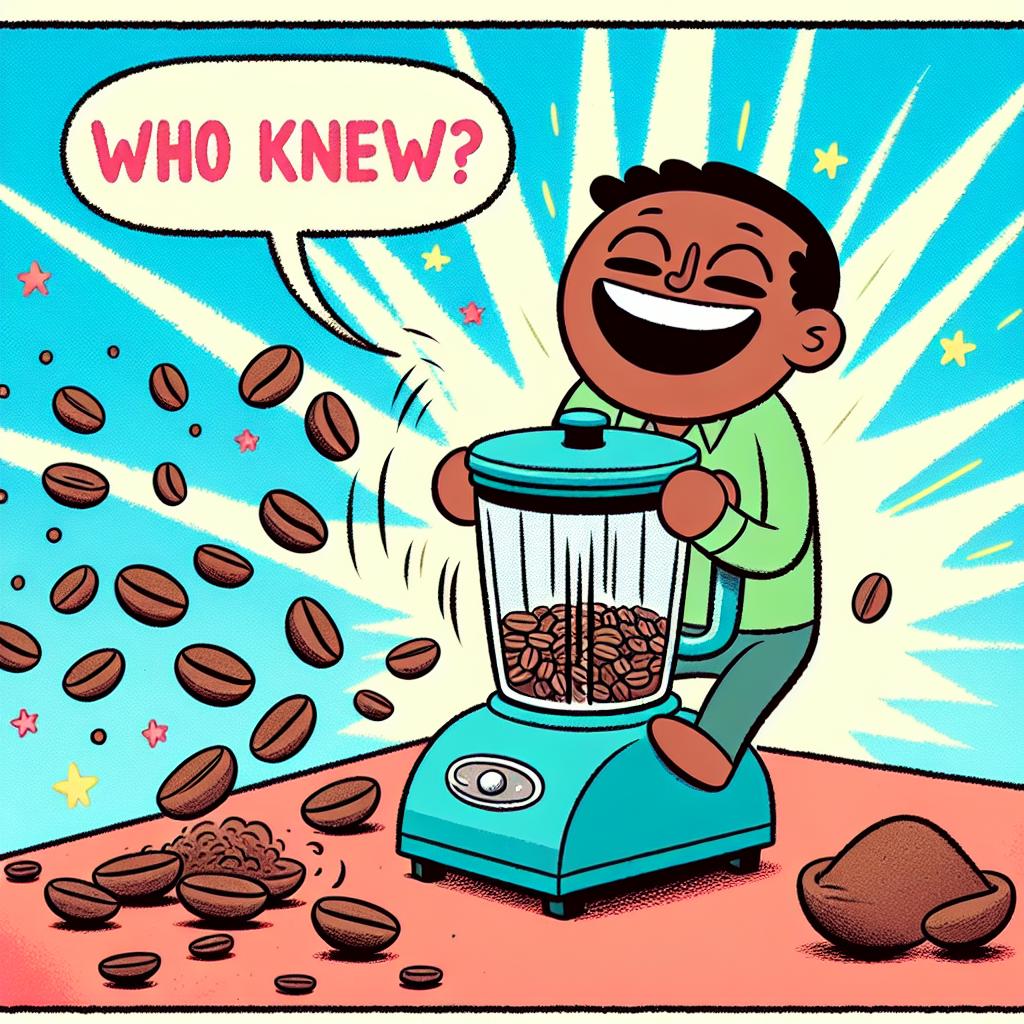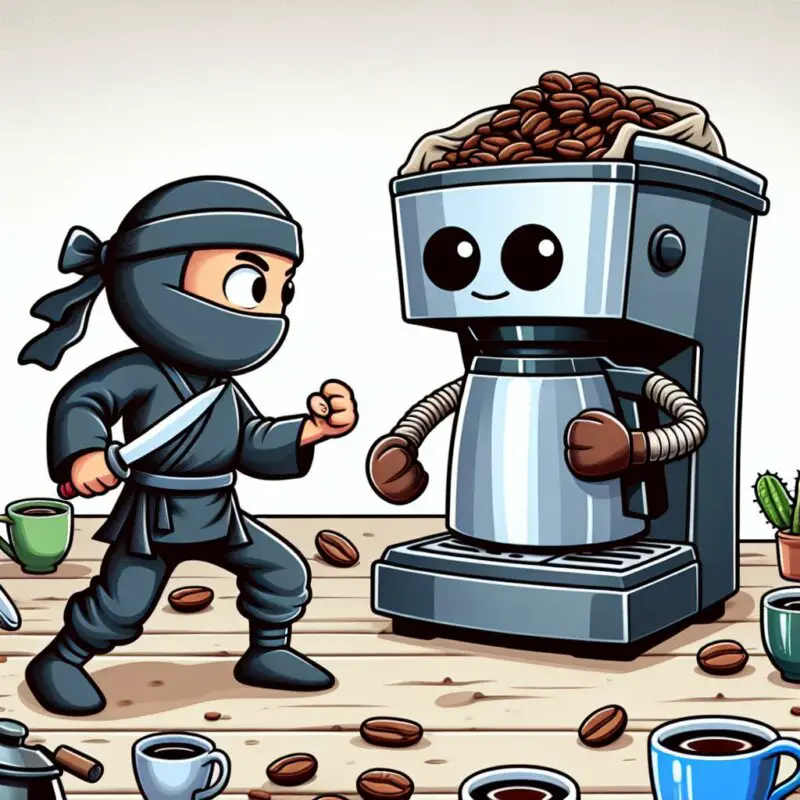This post may contain affiliate links. Please read my disclosure for more info.
When your coffee grinder quits early in the morning, don’t panic. There’s always another kitchen gadget ready to save your coffee day. Can you guess which one can grind those beans?
In this post, we’re diving into a common question: Can you grind coffee beans in a blender? We’ll explore the pros and cons of using a blender like a Vitamix or Ninja and share tips for achieving the perfect grind at home.
Can You Grind Coffee Beans in a Blender?
Absolutely, a blender can grind coffee beans, but for a truly great cup, opt for a quality burr grinder. Even an affordable coffee grinder beats a blender any day.
Your blender and a blade grinder chop coffee beans into grounds using fast-spinning blades, working in a similar way. Perfect for beginner coffee lovers!
The Downsides of Using a Blender for Grinding Coffee
1. No grind size controls
Burr grinders crush coffee beans between two burred plates, creating uniform grounds. As beans get finely ground, they drop into a bin. Whether you choose a flat or conical burr grinder, you can adjust the grind size to your liking by changing the space between the burrs. Perfect for beginners wanting to explore coffee grinding!
Adjusting the distance between the grinder plates changes your coffee’s destiny! Close together, they create the fine powder perfect for espresso and even finer for Turkish delights. Spread them out, and you get medium bits ideal for drip brews, or go coarser for the best cold brew and French press coffee.
Blenders lack specific settings for grinding coffee. While you can blend beans longer for a finer texture, it’s hard to get the exact grind size you need every time. It’s not a precise method.
2. Poor grind uniformity
Nailing the perfect grind size is just the start. Imagine this: some beans get chopped up multiple times, while others barely get a scratch. What you end up with in your fine grind is a mix of big, medium, and tiny pieces all jumbled together.
If your coffee grind isn’t even, you’re in for a bad cup. Large pieces won’t soak up enough, while tiny bits will soak up too much. This mix-up means your coffee might taste too bitter, and your espresso could come out watery or sour, no matter how hard you try.
Burr grinders are coffee game-changers! They work by only letting coffee grounds pass through when they’re just the right size. This means you get super even, perfect coffee grounds every time. The result? Incredibly smooth and tasty coffee, cup after cup.
How to Grind Coffee Beans With a Blender
1. Add the beans to the blender
To make a perfect cup of coffee, grind the right amount of beans. Use 16 grams (a bit more than 3 tablespoons) for an eight-ounce cup. Just add them to your blender and start grinding!
2. Grind the coffee beans
For a perfect grind, pulse your beans: short bursts of grinding followed by pauses. Repeat until they reach the consistency you love.
Don’t just dump your coffee beans into the blender and hit blend. To get evenly ground coffee, gently tilt or shake the blender now and then. This stops big chunks from hiding under the blades.
For amazing coffee, pick the fastest blend setting. If it has a grind option, go for it! Otherwise, any quick speed works great.
After grinding beans for your first coffee, take the grounds out of the blender.
3. Repeat the process for more cups of coffee
To whip up another cup of coffee, simply toss more beans into the blender and follow the same steps. Grinding beans for just one cup at a time ensures they don’t jam the blender’s blades.
Why Do We Grind Coffee, Anyway?
Sure, you might think about just throwing your whole coffee beans into the pot and adding water to brew whole bean coffee. But, if you grind them first, you give the water more coffee to soak into, making your brew even tastier.
Think about it like this: Brewing whole beans means only the outside gets wet. The inside? It stays dry, keeping all its flavor locked away. You miss out on the good stuff!
When you grind coffee beans, you let water touch both the inside and outside parts of the bean. If you use whole beans, your coffee might taste bland. But ground coffee? That’s where the bold and rich flavors are. Who doesn’t want a more delicious cup of coffee?
The size of your coffee grounds makes a big difference in brewing time. If you use whole beans, it could take days to get all the flavor out. But, if you’re using grounds for drip coffee, you’ll have a delicious cup in about five minutes. For espresso lovers, finely ground coffee can brew in just one or two minutes, especially if you’re using one of the best espresso machines that apply lots of pressure to speed up the extraction.
Why Not Just Buy Pre-Ground Coffee?
Freshly ground coffee offers a better taste compared to pre-ground coffee. Why? Pre-ground coffee can become stale just hours after opening. The special flavors in coffee start to fade fast once the beans are ground.
No matter if you brew it immediately or wait, your pre-ground coffee’s taste begins to fade the moment it’s ground. Often, it’s already losing its fresh, rich flavor before you even bring it home from the store.
If your go-to French press grinder breaks, a blender can save the day by grinding your coffee beans.
Frequently Asked Questions
Can I grind coffee beans in a Ninja?
All Ninja blenders are capable of grinding coffee beans. A small, high-powered blender like the Ninja BL480D is best as there is less room for beans to fall away from the blades. And, of course, no Ninja blender works as well as a burr grinder.
Can a Vitamix grind coffee?
Vitamix blenders have the power needed to handle grinding coffee beans. However, their popular models like the Vitamix E310 are larger than I would recommend for such a task. It can be done, but you’ll need to be careful to tilt the machine between short pulses to make sure that all of the beans get ground up evenly.
What’s Next?
Using a blender to grind your coffee beans is a last-ditch effort. If you’re in a bind, Starbucks can grind them for you. But it’s a good idea to have a compact travel coffee grinder as a backup. Alternatively, consider coffee machines that come with a built-in grinder to simplify your coffee-making process.
Having a coffee grinder is great, but not everyone enjoys grinding beans. If you prefer an easier route, consider pod machines like the Nespresso VertuoPlus or the Keurig K-Supreme Plus Smart. They’re simple and convenient!




